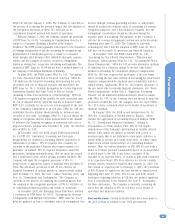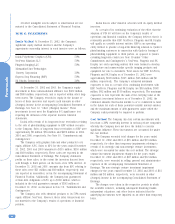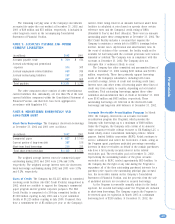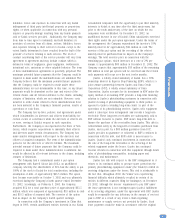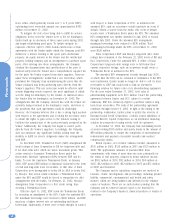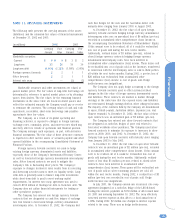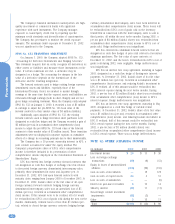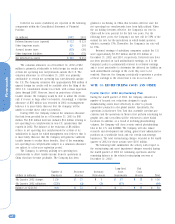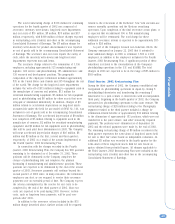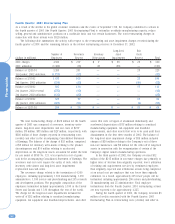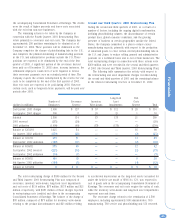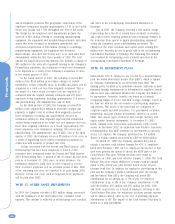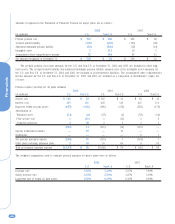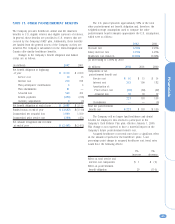Kodak 2002 Annual Report Download - page 59
Download and view the complete annual report
Please find page 59 of the 2002 Kodak annual report below. You can navigate through the pages in the report by either clicking on the pages listed below, or by using the keyword search tool below to find specific information within the annual report.
Financials
59
NOTE 11: FINANCIAL INSTRUMENTS
The following table presents the carrying amounts of the assets
(liabilities) and the estimated fair values of financial instruments
at December 31, 2002 and 2001:
(in millions) 2002 2001
Carrying Fair Carrying Fair
Amount Value Amount Value
Marketable securities:
Current $9$9$3$3
Long-term 25 26 34 34
Long-term debt (1,164) (1,225) (1,666) (1,664)
Foreign currency forwards 2211
Silver forwards 2211
Interest rate swap —— (2) (2)
Marketable securities and other investments are valued at
quoted market prices. The fair values of long-term borrowings are
determined by reference to quoted market prices or by obtaining
quotes from dealers. The fair values for the remaining financial
instruments in the above table are based on dealer quotes and
reflect the estimated amounts the Company would pay or receive
to terminate the contracts. The carrying values of cash and cash
equivalents, receivables, short-term borrowings and payables
approximate their fair values.
The Company, as a result of its global operating and
financing activities, is exposed to changes in foreign currency
exchange rates, commodity prices, and interest rates which may
adversely affect its results of operations and financial position.
The Company manages such exposures, in part, with derivative
financial instruments. The fair value of these derivative contracts
is reported in other current assets or accounts payable and other
current liabilities in the accompanying Consolidated Statement of
Financial Position.
Foreign currency forward contracts are used to hedge
existing foreign currency denominated assets and liabilities,
especially those of the Company’s International Treasury Center,
as well as forecasted foreign currency denominated intercompany
sales. Silver forward contracts are used to mitigate the
Company’s risk to fluctuating silver prices. The Company’s
exposure to changes in interest rates results from its investing
and borrowing activities used to meet its liquidity needs. Long-
term debt is generally used to finance long-term investments,
while short-term debt is used to meet working capital
requirements. An interest rate swap agreement was used to
convert $150 million of floating-rate debt to fixed-rate debt. The
Company does not utilize financial instruments for trading or
other speculative purposes.
The Company has entered into foreign currency forward
contracts that are designated as cash flow hedges of exchange
rate risk related to forecasted foreign currency denominated
intercompany sales. At December 31, 2002, the Company had
cash flow hedges for the euro and the Australian dollar, with
maturity dates ranging from January 2003 to August 2003.
At December 31, 2002, the fair value of all open foreign
currency forward contracts hedging foreign currency denominated
intercompany sales was an unrealized loss of $4 million (pre-tax),
recorded in accumulated other comprehensive (loss) income in
the accompanying Consolidated Statement of Shareholders’ Equity.
If this amount were to be realized, all of it would be reclassified
into cost of goods sold during the next twelve months.
Additionally, realized losses of $1 million (pre-tax), related to
closed foreign currency contracts hedging foreign currency
denominated intercompany sales, have been deferred in
accumulated other comprehensive (loss) income. These losses will
be reclassified into cost of goods sold as the inventory transferred
in connection with the intercompany sales is sold to third parties,
all within the next twelve months. During 2002, a pre-tax loss of
$20 million was reclassified from accumulated other
comprehensive (loss) income to cost of goods sold. Hedge
ineffectiveness was insignificant.
The Company does not apply hedge accounting to the foreign
currency forward contracts used to offset currency-related
changes in the fair value of foreign currency denominated assets
and liabilities. These contracts are marked to market through
earnings at the same time that the exposed assets and liabilities
are remeasured through earnings (both in other (charges) income).
The majority of the contracts held by the Company are denominated
in euros, British pounds, Australian dollars, Japanese yen, and
Chinese renminbi. At December 31, 2002, the fair value of these
open contracts was an unrealized gain of $7 million (pre-tax).
The Company has entered into silver forward contracts that
are designated as cash flow hedges of price risk related to
forecasted worldwide silver purchases. The Company used silver
forward contracts to minimize its exposure to increases in silver
prices in 2000, 2001, and 2002. At December 31, 2002, the
Company had open forward contracts with maturity dates ranging
from January 2003 to May 2003.
At December 31, 2002, the fair value of open silver forward
contracts was an unrealized gain of $2 million (pre-tax), recorded
in accumulated other comprehensive (loss) income. If this amount
were to be realized, all of it would be reclassified into cost of
goods sold during the next twelve months. Additionally, realized
losses of less than $1 million (pre-tax), related to closed silver
contracts, have been deferred in accumulated other
comprehensive (loss) income. These gains will be reclassified into
cost of goods sold as silver-containing products are sold, all
within the next twelve months. During 2002, a realized loss of $3
million (pre-tax) was recorded in cost of goods sold. Hedge
ineffectiveness was insignificant.
In July 2001, the Company entered into an interest rate swap
agreement designated as a cash flow hedge of the LIBOR-based
floating-rate interest payments on $150 million of debt issued June
26, 2001 and maturing September 16, 2002. The swap effectively
converted interest expense on that debt to a fixed annual rate of
4.06%. During 2002, $2 million was charged to interest expense
related to the swap. There was no hedge ineffectiveness.


